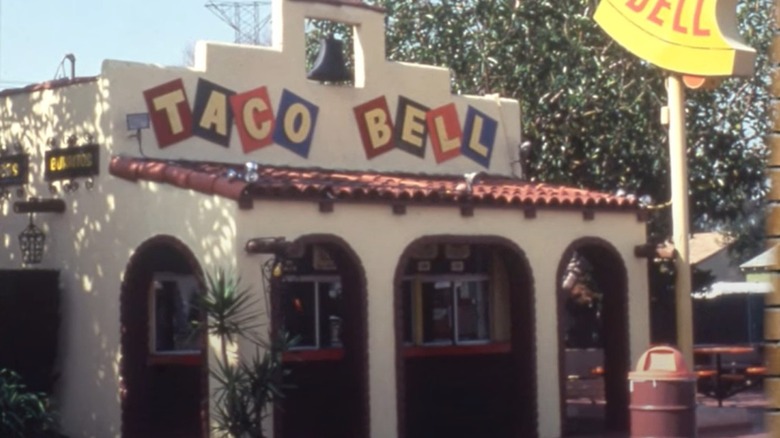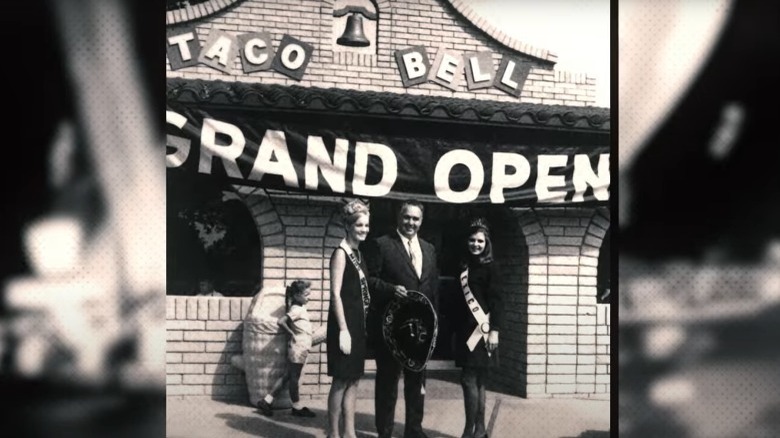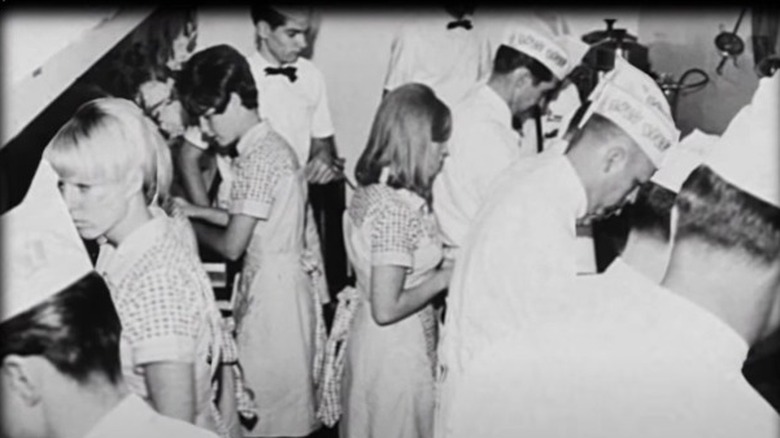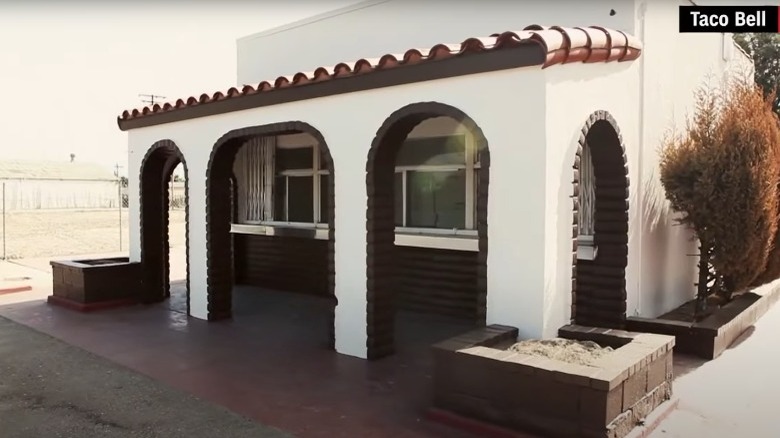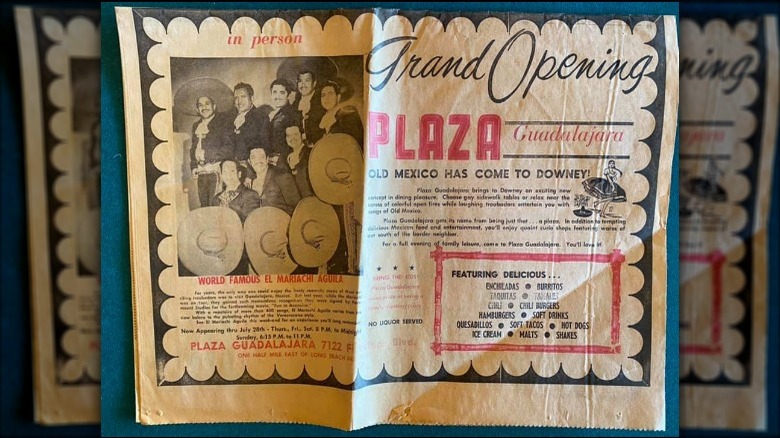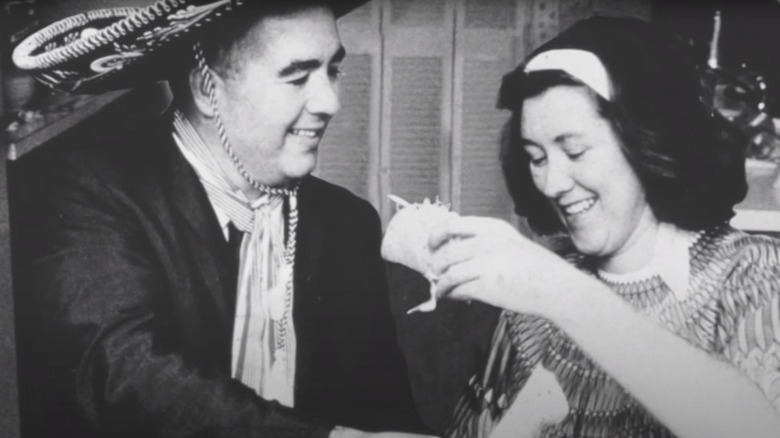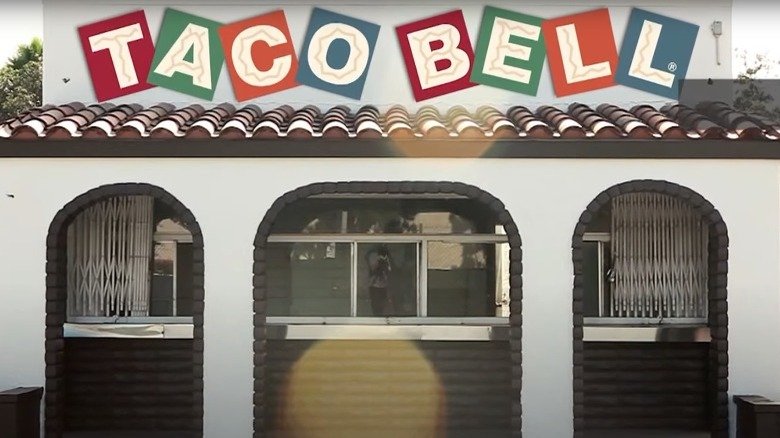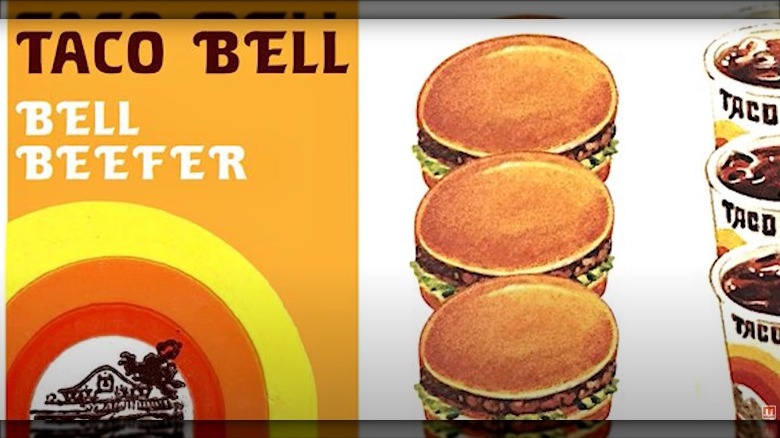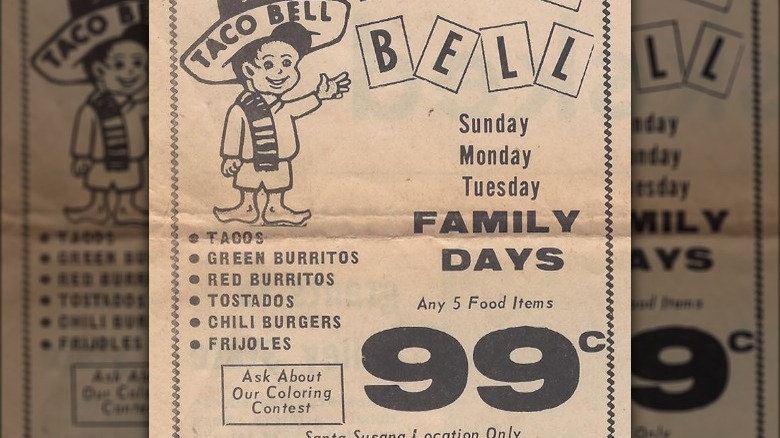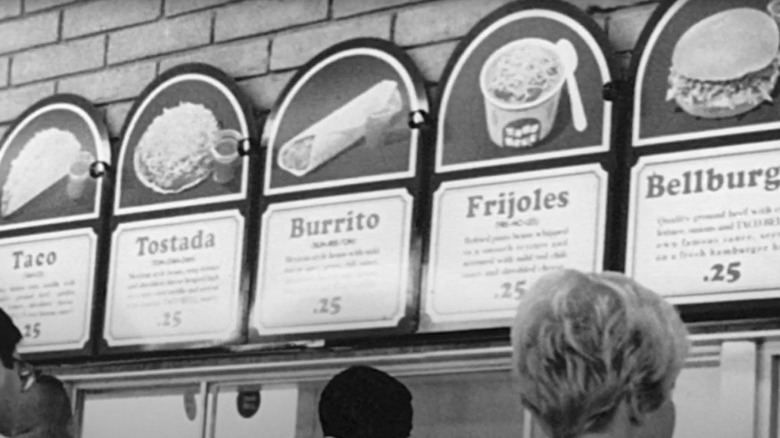What It Was Really Like To Eat At The First Taco Bell
Even if the rest of the world thinks Taco Bell's tacos are not Mexican enough, for a majority of Americans, it's still the favorite Mexican restaurant (via a 2018 report by People). While the Mexican food chain didn't succeed in Mexico, it celebrated its 60 glorious years in the United States in March 2022 with the launch of a vegetarian combo (via Taco Bell). Today, Taco Bell regales us with a constantly changing menu, but back in 1962, at the first Taco bell, things were different. Besides the fact that it had a fixed scanty menu, the first Taco Bell was a beige-colored building with a large decorative bell on top (via Huffpost). Over the years, the bell disappeared, the wall color changed to orange, and the building became just one of the 7,000 locations (via Yum!) of Taco Bell across the world. Having said that, it did have a long and successful run — besides being Taco Bell's first home between 1962 and 1986, it had housed other businesses including a taqueria called Tacos Raul, according to Huffpost.
As of 2014, it was deemed too old to be operational, and was stripped off the location and transported 45 miles away from Downey to Irvine (via Thrillist). Today, it sits in Taco Bell's headquarters in Irvine, California, although,there are no tacos being fried in its kitchen or customers lining up at its windows as there were before.
You heard customers pronounce taco differently
Just as with the names of U.S. vice president Kamala Harris (it's Comma-la) and model Chrissy Teigen (it's Tie-gen), people butchered the pronunciation of taco back in the '60s, ordering a "tay-koh" instead of, well, "taa-koh" (via Taco Bell's website). But they couldn't have known better. When the chain was founded in 1962, tacos weren't as popular as other Mexican foods such as chilis, tamales, enchiladas, and frijoles, according to the book "Taco USA: How Mexican Food Conquered America." For example, chilis and tamales had made their way north of the border from Mexico as early as the 1890s, but the taco? Not until the '50s, explains author Gustavo Arellano.
While there was a smattering of the word's usage in Mexican cookbooks around the '30s, there was a good chance that few Americans outside of California and Texas heard of tacos until Taco Bell billowed into the rest of America. Even a decade after the first Taco Bell, Arellano writes, Glen Bell, the founder of the chain, traveled with a pronunciation guide and an ad of the chain's menu to places that hadn't heard of Taco Bell yet (like Florida). Bell certainly did change the eating habits of the nation, as he writes in his biography "Taco Titan" — while also correcting its pronunciation, one tay-koh at a time.
There was no space to sit inside
While today, you can find rows of digital ordering kiosks and dining booths inside the 2,500 square foot (via The Street) space of a Taco Bell, the very first unit was too small to have people sit and chitchat over a burrito. It was housed in a compact 20 by 20 foot space (via Britannica) — that's roughly enough to park two cars. Customers were required to place their orders through a walk-up window (via Huffpost). Though Glen Bell, the founder of Taco Bell, had previously run restaurants that included drive-thrus, like Bell's Drive-in in San Bernardino, and a drive-thru taco stand called Taco Tia (via The Downey Patriot), at his first Taco Bell unit, he didn't give customers the option to holler for their frijoles from the comfort of their four-wheelers.
The walk-up windows, as mentioned on the Institute of Culinary Education's website, were quite popular in Southern California between the late '40s and '50s. And turns out, what was thought to be an antiquated concept is making a comeback. The old-school style of serving customers a limited set of menu items through a crack of a window became popular with the need to distance socially during the 2020 pandemic.
The building was reminiscent of the architecture in Mexico
In the '50s, when the McDonald brothers were killing it with their hamburger business in San Bernardino, California, Taco Bell's founder, Glen Bell, opened his own burger stand a short distance away (via The New York Times). Customers didn't share the excitement, and he was pushed to innovate. Bell didn't just change a menu item or two, but the entire cuisine. Seeing the buzz at the Mexican restaurant that his burger stand stood opposite to, Bell decided that instead, he was going to start a taco stand. But he didn't stop there; when the time came to build the first Taco Bell restaurant, he wanted it to pass the Mexican vibe check.
Bell asked architect Robert McKay to make the structure look like the buildings in Mexico, per his biography "Taco Titan" (via Orange County Register). Using an allocated budget of $8,500 (per Bloomberg), McKay designed a Mission-style building (an architectural-style inspired by the churches built by Spanish colonials between 1770s and 1820s, per Love to Know) that had stucco walls, archways, and rooftops made with tiled bricks. Today, Taco Bell looks nothing like the numero uno building, but "[...] Taco Bell's architecture of the '60s and '70s remains as one of the most recognizable and iconic designs of the era," per the chain's statement. In 2016, Taco Bell decided to bring back the Mission-style for some new stores (via Penn Live), a modern twist to the original design.
It had a Mexico-themed strip mall next to it
You couldn't have gotten a chilled Baja Breeze at the first Taco Bell, but you might have been able to hear troubadours sing songs of Old Mexico while chugging your root beer. Turns out, a year following the launch of Taco Bell's first restaurant, Glen Bell built a strip mall right next to it. While Taco Bell sat at 7112 Firestone Boulevard on Downey Street, the strip mall called Plaza Guadalajara was at 7122 Firestone Boulevard, as per The Downey Conservancy. Since the Taco Bell and the Plaza were all on the same complex on Firestone, you could take your order of tostadas and sit at a table on the sidewalk, or next to an open fire, while listening to Mariachi bands croon, per a 1963 ad (via Facebook).
The mall included open air shops (via KCET), and was built in a similar Mission-style design that Taco Bell boasted (via Huffpost). One of the shops was a burger and hotdog stand that owners of the chains Taco Quickie and Quickie Dog ran back then (via Facebook). The mall was advertised as a hub for Mexican food, entertainment, and curio shops featuring Mexican wares. The 1963 ad marked its festive opening with: "Old Mexico has come to Downey!" Bell had certainly chosen a striking location to set up shop, for Downey was getting incredibly popular for its aerospace industry (via KCET) and Firestone, one of the busiest streets, per The Downey Conservancy.
The tacos were fried in makeshift baskets
Despite his ex-wife's outright discouragement, Glen Bell was bent on making his tacos the talk of the town. Learning to fry the tortilla in hot oil was no biggie. What he racked his brains for was a way to make the process quick and easy. While Bell waited for some bells to ring on this front, a chef in New York, and yet another in Arizona, had received patents for devices that fried several tortillas at once, in the early 1950s (via "Taco USA"). Bell, sitting in the far West, was probably unaware of these developments in the taco-verse, for he seemed to have come up with his own way of streamlining the taco-making process. He reached out to a chicken coop producer, as mentioned in his biography "Taco Titan" (via KCET). He didn't want a plump chicken, but just the chicken wire that keeps them securely caged.
Using these wires, he weaved a basket that would fry as many as six tortillas at a time. Once fried, instead of heaping them into a taco hill, he decided to align them neatly on a "taco trail" so that he could pluck one off, stuff and serve it in a jiffy. Today, you won't see Taco Bell staff frying tortillas in chicken wire baskets of course — as per a Taco Bell manager on Reddit, the shells come pre-made, and the staff just have to put in the toppings.
Its signboard looked nothing like what it is today
It's not that we need a particularly glitzy signboard to buttress our crunch wrap loyalty, but it is to be noted that the chain's logo has been draining color since the time of its founding. Today, it is a plain-looking white bell on a purple background, a design it adopted in 2016. This is a far cry from the original logo that showed a man in a sombrero sitting on a bell, per Atlas Obscura. Also, the building sported a design that looked like a bunch of colorful blocks left around carelessly by a toddler. Over the years, the Taco Bell logo, just like its menu, has undergone significant changes.
Between 1996 to 2016, the logo was a pink bell on a blue background. It had a yellow clapper that sparked a whole debate on whether it was an ingenious design twist to the image of a taco (via Reddit). Taco Bell adopted a more mellowed down version since 2016, as it allowed for easy customization for campaigns and promotions (via AdAge). The creative agency Fabrik Brands mentions on its website that at one point the bell was a lemon yellow color with a reddish-orange background. If you trace the history of Taco Bell's logos further back, you arrive at a monochrome design, with no hint of color, but just alphabets written in black. It was the mid '70s, and Taco Bell, like any other teenager, was probably still developing a personality.
It sold the Bell Beefer by a different name then
The first Taco Bell had a menu item that probably didn't contribute to its Mexican vibe, but was loved by its customers, nonetheless. As those who are part of the "Taco Bell Please Bring Back the Bell Beefer ” Facebook group might have guessed by now, we are talking about the chili burger. It rested next to the tacos and tostadas on the chain's first-ever menu, like a delicious oddball. While most might have only heard of the Bell Beefer, it has been called by different names over the years. For example, the chain's original menu had the Chili Burger, which was later called Bell Burger for a while (via Newsnation), and then became Bell Beefer (via The Takeout).
Bell Beefer was made like a Sloppy Joe, with ground spiced taco meat tucked in between two hamburger buns along with tomatoes, onions, lettuce, and cheeses. The popularity of Sloppy Joes, and hence the Bell Beefers, apparently slumped as the years went by, forcing the chain to remove it from the menu. But it turns out that some had found it "outstanding" and "loved them more than anything else they [Taco Bell] ever made," per reviews on the "Taco Bell Please Bring Back the Bell Beefer" Facebook group. (Is Taco Bell listening?)
The original menu just had five items
Unless you know what you really want, browsing through Taco Bell's menu is much like leafing through the pages of a novella. It's expansive, and takes time. Plus, there is the big task of deciding whether to go for the pizza combo or a chalupa deluxe box, have a cinnamon twist or not. At the first Taco Bell, though, things were relatively simple. Right above the walk-up window was a menu board that featured a total of five items, including frijoles, tostados, chili burger, burritos (red and green) and tacos (via Newsnation). Just to put things into perspective, the list is shorter than the number of menu items that the chain removed from its menu in 2020 (as many as 11, per CNN).
Beverages? At the first Taco Bell you could order a coffee, root beer, Coke, or orange juice. Today there is a ton of other options, including a variety of freezes and sparkling iced tea. But no Coke. Taco Bell was bought by PepsiCo in 1978 (via Funding Universe) and later let Yum Brands handle its fast food chains, such as Taco Bell and Kentucky Fried Chicken. Ever since, the Yum Brands restaurants have stayed loyal by serving only Pepsi products.
Each menu item cost just 19 cents
Today, 19 cents might excite a child who wants to be a numismatist. Otherwise, for a grocery shopper or a restaurant hopper, it's of little use. But back in the summer of '62, 19 cents could buy you a whole chili burger, or really, any of the other menu items at the first Taco Bell. The prices, apparently, remained stable until the '70s, when Taco Bell was no longer a fledgling fast food chain but one that was worth a whopping $6 million (via Funding Universe). As per a Newsnation report, the chain jacked up the menu prices to 25 cents an item in the early '70s. Still a lot cheaper than a $1.19 for a crunchy taco as of 2022, per Fast Food Menu Prices.
With $1.19, you could have bought all the menu items and then some, at the first Taco Bell. As per an old Taco Bell promo, a customer could pick any five items from the menu for 99 cents, at a certain location. To the nostalgic ad posted on the Facebook group "Taco Bell Please Bring Back the Bell Beefer," a certain user commented, "Oklahoma City had sales like this. I was 16 driving my 1957 Chevy. Gas was 29 cents per gallon. Those where the good old days." Good old days, indeed.
